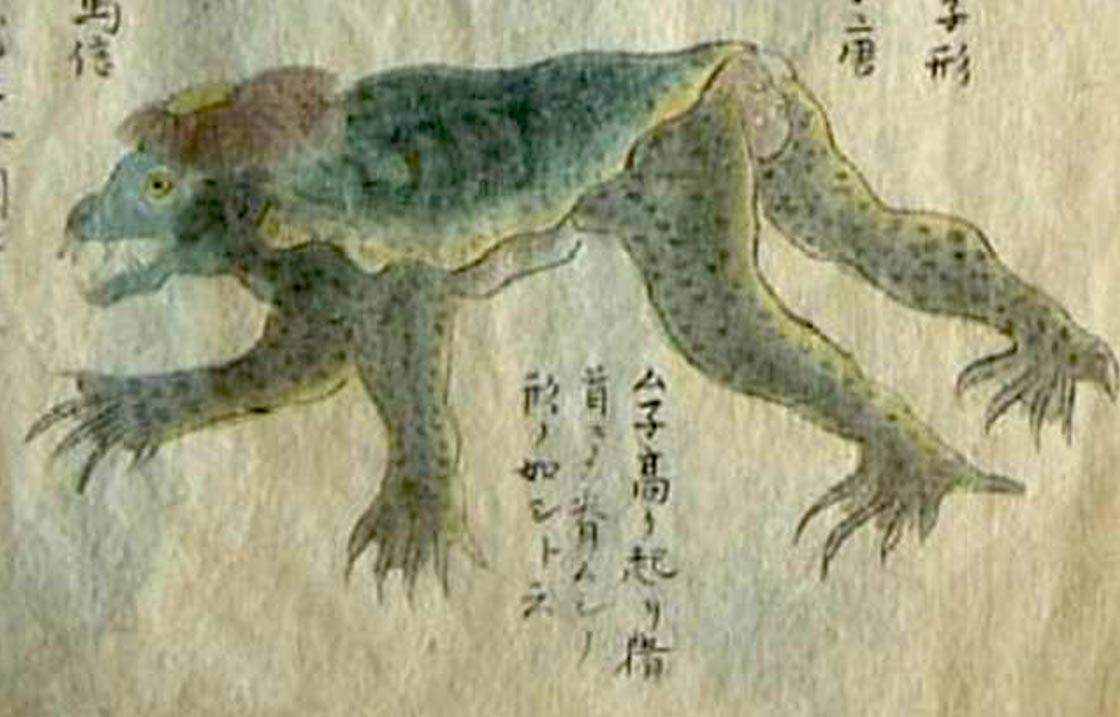
The Strange Origin of the Kappa: Japanese Water Imp
Many supernatural creatures are depicted in Japanese art and literature. Some seem realistic and might actually exist, since there have been witness sightings, while others are clearly composite creatures. Still others might have been created by storytellers to explain seemingly inexplicable phenomena. Such creatures include yuki-onna (snow women), who lure young men out of their beds at night and into the mountains where they freeze to death, and kitsune (foxes) which are thought to be shape shifters, often assuming the form of beautiful young women. Even today in northern Japan, some people who are suffering from psychological issues are thought to be possessed by foxes. Where some of these ideas originated is unknown. And in some unique cases, there are many possible origins for a particular creature’s existence, with evidence to back up all such possibilities. This is the case with the kappa (water imp).
The size of a small child, it has greenish skin and is sometimes artistically depicted with a turtle shell or fish scales, even though witness reports never indicate such scales or shell. It is likely that this artistic embellishment was put into place to indicate that it is, in fact, a water-abiding creature. It supposedly lives in lakes, ponds, and sometimes rivers, and it is generally always found in the water or next to it. This is due to another unusual attribute that the creature has. The kappa is described as having an indentation on the top of its head. While this indentation is filled with water, it is much stronger than a normal human being, but if it empties, it becomes as weak as a human child and can be defeated easily.
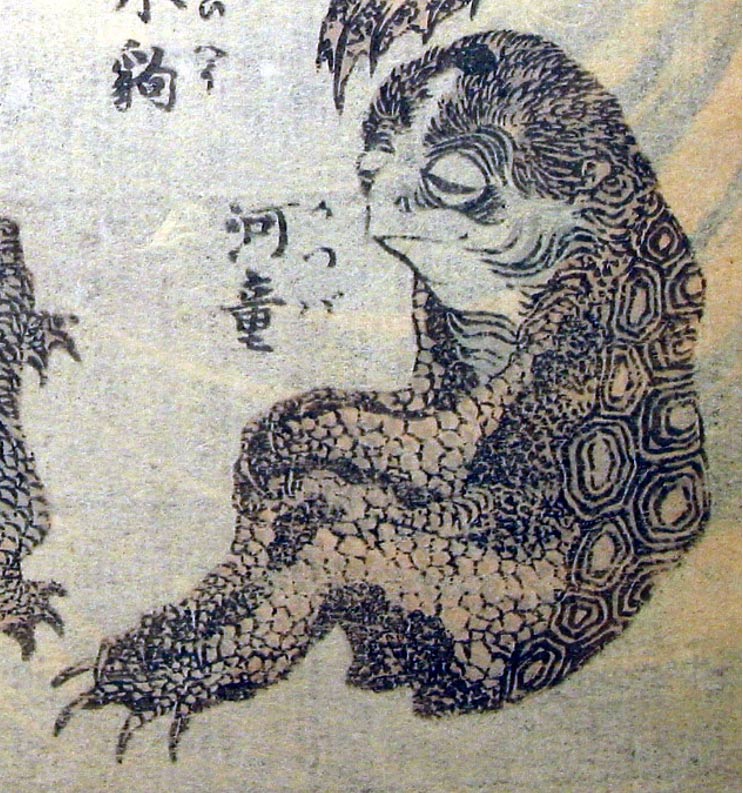
A Japanese bestiary drawing depicting a Kappa demon (c. 1760 – 1849). Public Domain
It is said this creature taught humans how to set bones. According to legend, there was once a kappa that looked especially like a human child. It coaxed many to the water, pretending that it wanted to play pull-finger. Once they touched its hand, it grabbed them and drowned them. To stop this mischievous creature, a villager approached on horseback and when the kappa invited him to the river bank, he did so, and reached out to grab the kappa’s finger. As soon as the man took hold, he spurred the horse into a gallop, dragging the creature away from the river and spilling the water that filled the indentation on its head. Thus weakened, the creature begged for its life, promising to teach the man something of value in return. It taught him the art of bone setting, and it further promised to never harm any human being in the area again (Davis, 1992). This is not the only time a kappa was said to have been controlled by means of emptying the water from the top of its head. The creature is considered especially polite, even to its intended victims. If a person bows to it, it will bow back, generally spilling its water and making it weak.
Beyond occasionally drowning people, the creatures has been thought to rape women and exsanguinate humans and other creatures. Like a vampire, it sticks its teeth into human and animal flesh and drinks the blood. However, these creatures do it in an unusual way. Vampires and vampiric creatures are found in cultures all over the world, but this might be the only one that prefers to feed from anuses. This is why, even today in rural areas, humans or animals found in or near bodies of water with distended anuses are thought to have been victims of kappa attacks (Piggott, 1969).
To protect their children, some Japanese parents continue to inscribe their children’s names onto cucumbers, which they float downriver; this is because the kappa are supposed to love cucumbers, and after receiving the gift, they leave the families alone. This legend is the reason a cucumber roll is called a kappa-maki (kappa roll) instead of a kyuri-maki (cucumber roll).
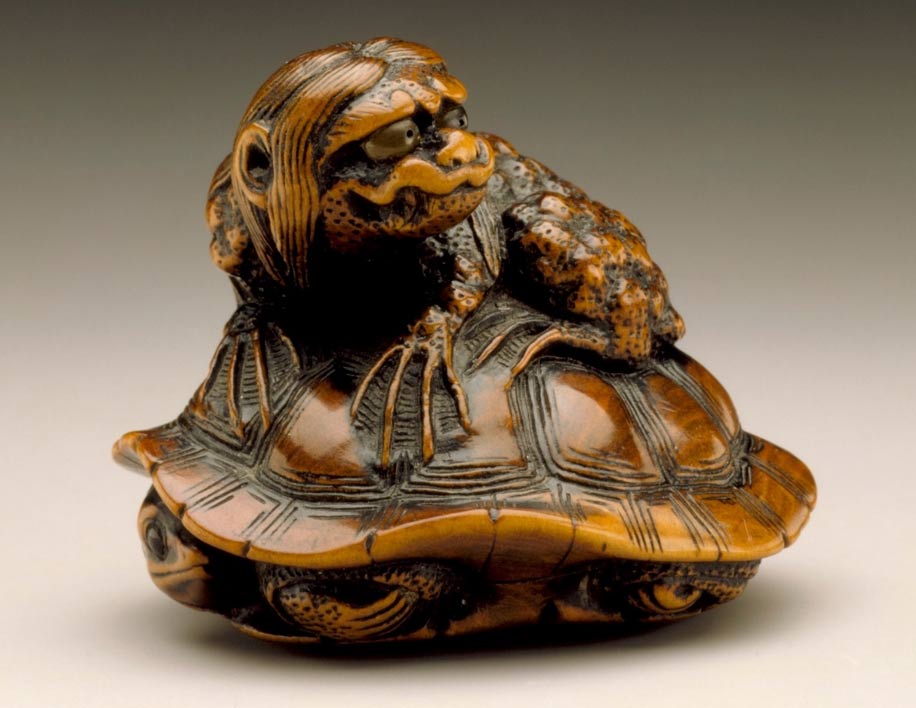
Kappa astride turtle, by artist Naito Toyomasa (1773-1856) (Image is in the public domain. Made available as part of the Wikimedia Creative Commons license)
Another bizarre story highlights the kappa’s fascination with anuses. One evening, a kappa emerged from the water and began exploring a nearby farm. In the field, it saw a tethered cow. Sneaking up on it from behind, it jammed its entire arm up the cow’s rectum, and naturally, the cow jumped and began running around the field. The kappa’s arm was trapped, so it was thrown in various directions, thus spilling the water in its head indentation and making it weak. In its weakened condition, the cow’s thrashing ripped its arm clear off, and it scurried back to the river without it. The farmer was inside at the time of this alleged event, and he came outside to see what the commotion was. Finding the arm, he was naturally shocked, but he took it back inside with him, wondering what on earth could have occurred. Later that evening, the creature returned to the house and presented itself in front of the farmer. It begged for the arm, explaining that it only had three days to reattach it or it was gone forever. The man made the creature promise that it would never harm another human being or animal in the area, and once it acquiesced, he handed over the much desired appendage (Kappa, 2013).
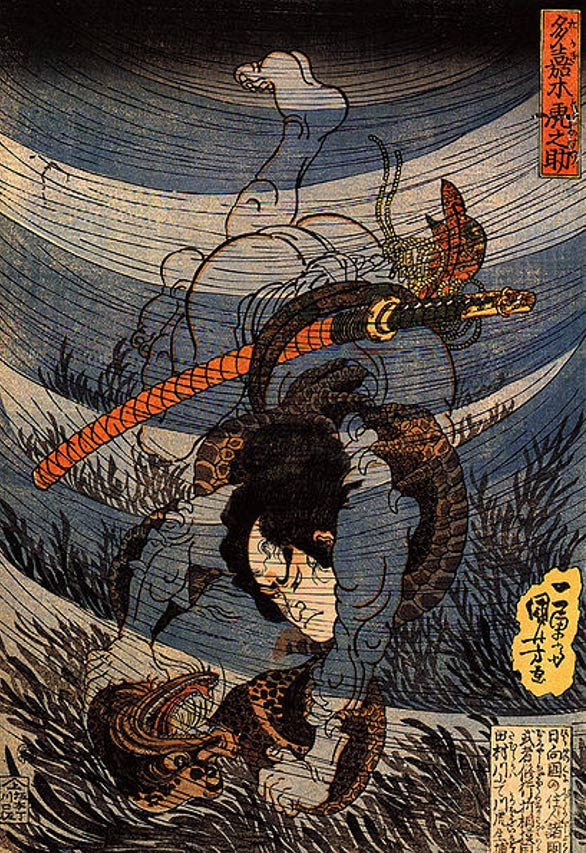
Illustration showing a man wrestling and capturing a kappa underwater. Public Domain
This creature is clearly one of the most unusual in not just Japan, but all over the world. Exactly where the notion of this creature’s existence came from is unknown, and there are various (unlikely) theories to explain it. It is possible that at some point in the late 1600s or early 1700s (since the creature does not appear in Japanese literature before this period) that some parents simply made up the story to keep their children away from water, thus saving them from potential drowning. Another potentiality highlights a tragic historical occurrence. At various times from the 1500s through the mid-1800s famines struck poor mountainous communities, especially in Yamagata, Akita, and Miyagi Prefectures. Not having enough food, on various occasions parents did the unthinkable: to save their children the torment of starving to death, they drowned them, sending their bodies downriver. It is possible that some people saw such bodies affected by water and did not recognize them as humans. Certainly, an extended period in the water will distort a human body’s shape and change its color. It is also possible that some parents struck their children on the head before depositing their bodies in water, which would thereby explain the indentation that kappa are said to have. Both of these theories, while possible, are not the most logical when confronting all the available evidence.
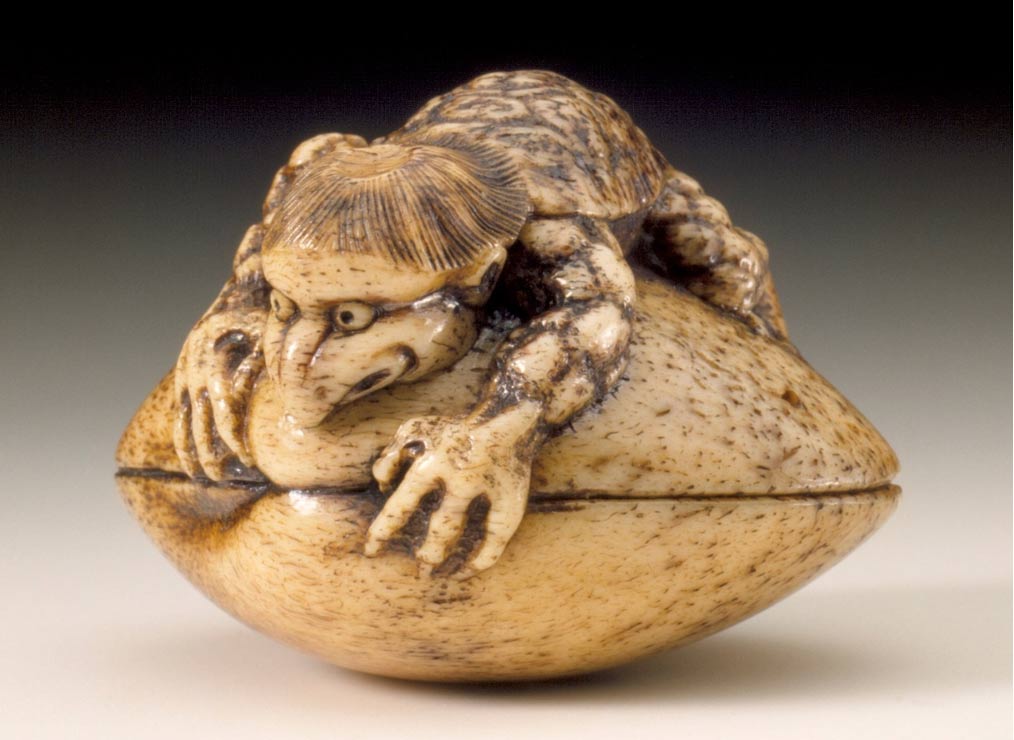
Kappa and clam, by artist Rensai (late 19th century) (Image is in the public domain. Made available as part of the Wikimedia Creative Commons license)
Another theory has to do with the notion of suijin (water entities). Many references to such beings are found in Japanese texts, and they include fish with mystical powers or paranormal abilities, turtles that are thought to be either immortal or involved in the world’s divine creation, or snakes and snake-like beings, which were likely adopted from the Hindu naga, a race of snake-like people who had advanced knowledge of both religious and secular phenomena. They also include dragons, dragon kings, and many other reptilian humanoids or river gods, which are likewise depicted as part human and part aquatic creature. Many of these creatures’ origins are found in the myths and legends of other countries like India and China, and they were adopted by the Japanese. Nevertheless, it is possible that the kappa is a truly unique Japanese being, and its portrayal was simply influenced by stories about suijin from other countries, and by preexisting artistic depictions of such chimerical beasts. The ancient Japanese text called the Nihon Shoki refers to a river god, and based upon perceived depictions of this deity, it is possible that the imp is an artistic (and playful) variation of the initial god mentioned in the eighth century historical text.
Anyone familiar with Edo-period wood-block prints and ukiyo-e subjects will understand how possible, and even likely, this is. The first known time the kappa was depicted in art was when it appeared in an encyclopedia of creatures called the Sansaizue, which was published circa 1713, but it did not become truly popular until the Edo Period, when artists were looking for new, unique and fun subjects. Craftsmen of the period often took traditionally depicted deities and mythological beings and put a new spin on them, thus making them comical or even goofy rather than serious, godly, or scary, depending on the nature of the beast.
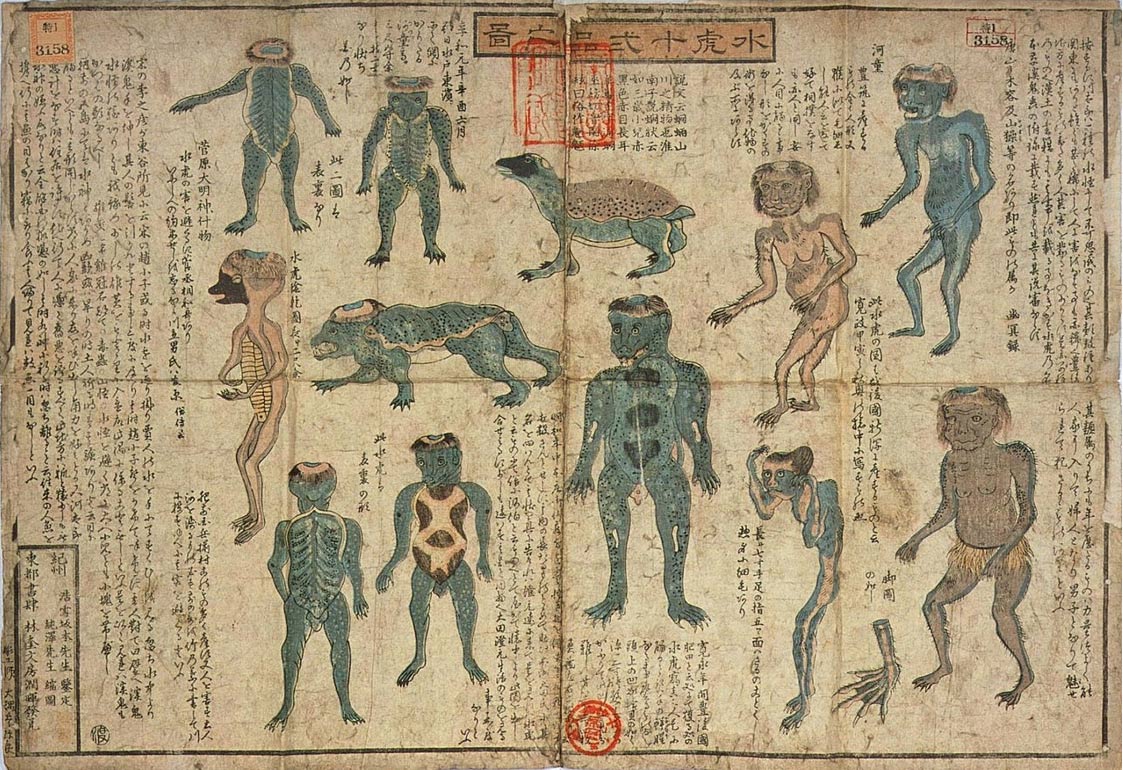
Kappa depictions in the Illustrated Guide to 12 Types of Kappa, by Juntaku (c. 1850). (Image is in the public domain. Made available as part of the Wikimedia Creative Commons license)
Another interesting theory regarding the kappa’s origin involves Portuguese monks, who had an unusual hairstyle when they first appeared in Japan. During the sixth century, the monks shaved the tops of their heads but left a ring of hair around the sides. Resembling a crown or a lower-than-usual halo, it also somewhat resembles the indentation thought to be found on kappas’ heads. (Look closely at some of the images in this article; it is clear that the indentations of the kappas’ heads are surrounded by hair.) This at first seems like a far-fetched connection, but there is some linguistic support to the theory. The word for the monks’ hoods in Portuguese was capa, which was pronounced the same as the Japanese word kappa. Still, there is no direct evidence that the kappa originated as a result of a direct connection with Portuguese monks, but it is possible that such monks, who were depicted in humorous ways by the Japanese five centuries ago (because they had unusual appearances) influenced the depiction of the kappa, which was most-likely adopted in a roundabout way from China (von Krenner & Jeremiah, 2015).
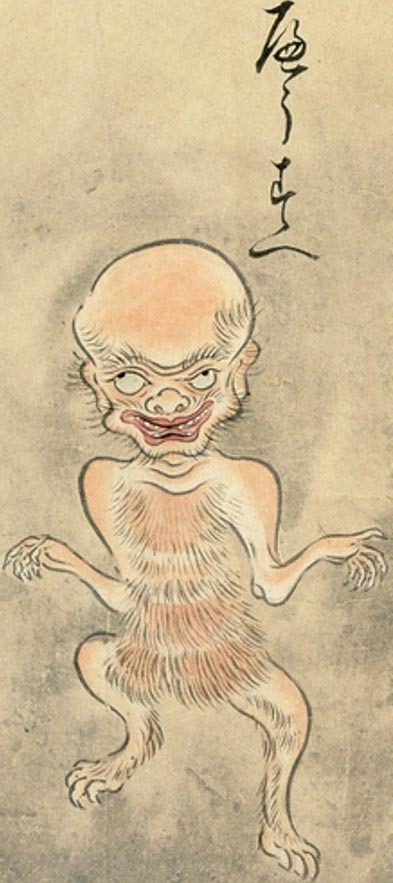
Hyōsube (a kind of hair-covered kappa that resembles an old man) from the Hyakkai-Zukan. Public Domain
The most logical theory of the kappa’s introduction ties it to China: specifically Chinese myths that describe a river god that had monkey messengers. Consider the potential artistic depictions of a water deity combined with a monkey, or think of this instead: How would artists represent a monkey that lived in the water and had semi-divine powers? This could explain why the kappa appears as it does. But, there is much more evidence to support this conclusion. First, let’s look at a linguistic one; the standard word for monkey in Japanese is saru, but in some parts of Japan, a different word is used: enko. Similarly, kappa is the standard word used to refer to water imps, but in some prefectures, enko is used: the same term used to refer to monkeys. (In Japan, the same terms are used for both real and supernatural variations of various creatures. For example, kitsune is a real fox, but also a shape-shifting supernatural one. Mujina is the real badger, but also a faceless, shape-shifting paranormal creature, and there are many more varieties. Since enko is used for both water imps and monkeys, an explicit connection can be drawn. There is much more:
In an originally Chinese story called the Enko Sokugetsu, a monkey leader saw the reflection of the moon in the water and gathered others together to procure it and return it to the sky. They headed out onto a thin branch, joined their tails together, and tried to accomplish the impossible. The branch snapped, and all the monkeys fell into the water, where they drowned. Today in Japan there are two proverbs connected to this story: “kappa no kawa nagare,” which loosely translates to “even the kappa can drown,” and “saru mo ki kara ochiru” (even monkeys fall from trees), which provides even more evidence of a monkey-kappa connection. Other stories highlight the same connection: In the Jataka, a collection of myths and legends from both Sri Lanka and India which was assembled in the fourth century B.C.E., one story talks about a monkey kingdom that a water demon threatened to destroy. A battle ensued, and the monkey king and his soldiers eventually defeated the water beast. Interestingly, the word used in this account for monkey was kapi (the Sanskrit word for monkey). It is possible that kappa is a distorted form of this original word (von Krenner & Jeremiah, 2015).
It is likely that the kappa legend came from the explicit connections between monkeys and water demons or deities found in Chinese, Indian and Sri Lankan texts, and its depictions were influenced by numerous other factors. No matter what, the creature is a popular subject in art and literature. It appears in carved figures like netsuke, woodblock prints, and paintings. It is a part of Japanese culture, and even if it is not real, like other legendary creatures worldwide, it nevertheless helps to define the culture in which it appears in one way or another.
Featured image: The strange and often dangerous water demon of Japanese legend, the Kappa. Drawing, 1836. Public Domain
References
−.(2013). Kappa: River Imp, Water Sprite. Onmark Productions. Retrieved from http://www.onmarkproductions.com/html/kappa.shtml.
−. (720). Nihon Shoki. Retrieved from http://ucblibrary3.berkeley.edu/jhti/Nihon%20shoki.html.
Davis, F. H. (1992). Myths and Legends of Japan. Michigan: Dover Publications.
Von Krenner, W. G. & Jeremiah, K. (2015). Creatures Real and Mythological in Chinese and Japanese Art. North Carolina: McFarland & Co., Inc.
Check out Ken’s website www.kenjeremiah.com, and follow him on Twitter @drkenjeremiah.